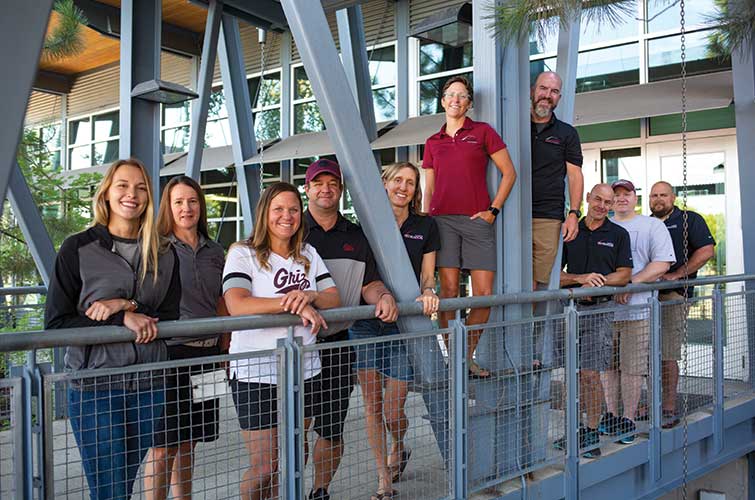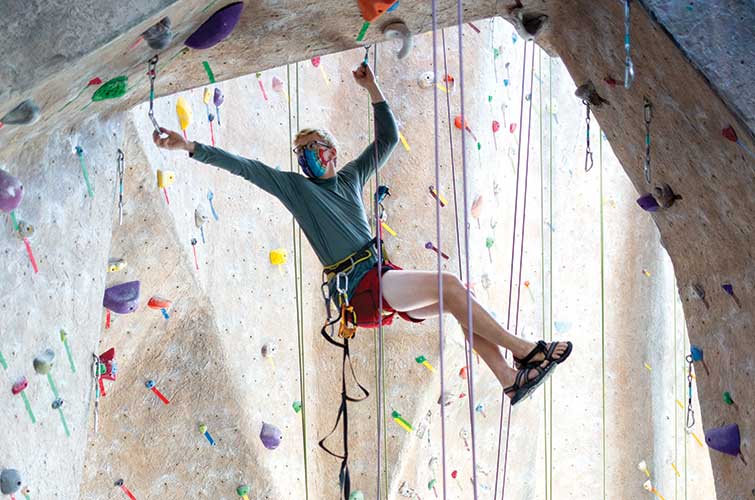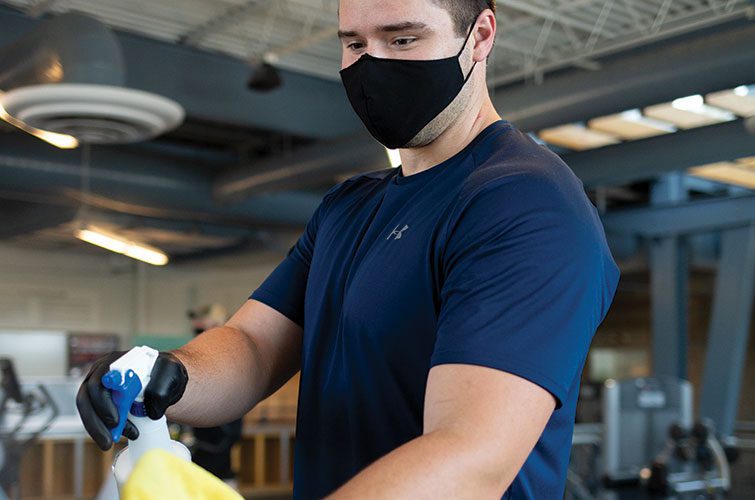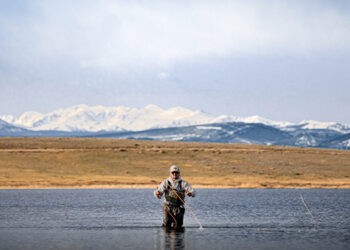Big Sky Country is the University of Montana’s (UM) backyard.
Situated in the town of Missoula, with a population of approximately 75,000 people and in the middle of a valley of mountains, the university’s students come for an education and a chance to explore “the last best place.”
For example, Clark Fork River runs through the middle of town and on a hot summer day, a plethora of people can be found floating, whitewater rafting and kayaking in its waters. Mount Jumbo and Mount Sentinel are just two of the many mountains surrounding the university, providing a variety of trails and activities, like the paragliders who often land near the campus’ University Golf Course. A ski hill is 30 minutes by car, and a 2.5-hour drive north will get you to Glacier National Park.
To say the outdoors is part of the Campus Recreation department is an understatement; it would be better said it’s ingrained in the culture and core of the team. On any given day, you might find one of the staff rocking Chacos or moccasins at work, leading a raft of campers down the river, or spending the weekend backpacking the Beartooth Mountains with their nine and 12-year-old.
“A department is defined by its people and its culture,” said Steve Thompson, the director of Campus Recreation. “We are laid back, casual yet professional, and supportive of one another. We genuinely enjoy being around each other. We are not the matching polo shirts and khakis kind of department. We do not have a uniform. In that way, we are reflective of the university and Missoula.”
In fact, the outdoors is found throughout the Fitness and Recreation Center — which is 20 years old but looks modern with its floor-to-ceiling windows and natural lighting. The facility features a 54-foot rock wall and bouldering area, and is home to the world-class UM Outdoor Program. Through a wide variety of trips, workshops and classes, students can learn to do anything from fly fishing to rock climbing to rolling a kayak. Rentals are another large part of making the outdoors accessible, open to members and nonmembers alike. Plus, the Grizzly Pool offers a variety of lessons, certifications and classes that focus on the outdoors, like log rolling with the Forestry Club.
Fittingly, the leader of UM’s Campus Recreation team has a rich history of outdoor recreation; in fact, Thompson said it’s an awesome crucible for future leaders to go through. There is nothing that quite teaches you about making decisions and implementing strategy than, say, leading a trip and being 400 feet from the mountain’s summit with a storm fast approaching. “It really teaches you to be creative with what you have,” he shared.
It’s then no wonder that crucible is being shared with incoming students through UM’s Freshman Wilderness Experience (FWE).
A four-day, three-night program, FWE sees over a hundred incoming first-year students head down rivers or into wilderness areas with upper classman guides. In 2019, there were 13 backpacking trips and one river trip for students to choose from. “The primary goals of this program are to foster peer networks and generate a sense of place with the university, Missoula and the surrounding wilderness,” said Thompson.
But the program hasn’t always been what it is now. Back in 2013, Elizabeth Fricke, the senior assistant director of the Outdoor Program, said after traveling to several conferences and seeing other orientation programs, she wanted to boost their own. That year she launched two backpacking trips for incoming freshmen.
Then in 2014, the Wilderness Institute on campus partnered with the Outdoor Program. This allowed for more permits, which increased the offering to six backpacking trips and one river trip. And by 2019, that trip number had nearly doubled.
The beauty of FWE is partly due to the fact students are out in the wilderness building community during one of the biggest transitions of their lives. Fricke said when the groups of eight to 10 students come back, it’s night and day in terms of how connected they are with each other. Plus, rules like no cellphones, or agreeing to not discuss topics like politics or drugs, allows them to go deeper with each other. “You have permission to be 100% yourself,” she said. “They get to know people they wouldn’t ordinarily have connected with, but they do because they are all on the same playing field [out there].”
But FWE is more than just a fun trip that connects freshmen. Another large part of the program is the fact the trips are student led. “We really want it to be student peer leadership focused,” said Fricke. “We want these students to get trained and lead these trips.”
FWE has even brought on a student coordinator, and a gear and food coordinator to help run the experience. They are the frontline for communicating, planning and training with the various trips and student leaders. Plus, Fricke pays her student leaders as she said it gives them more buy-in and she sees them as employees worth paying for.
As the program grew, the university took notice of the success and communicated it would like every student to experience FWE. Fricke noted that wasn’t possible due to the number of trips they would have to take, so they found a way to replicate the main ingredients of the program — namely small group, project-based and students leading students — with the Big Sky Experience launching in 2019.
During the three-day period of the Big Sky Experience, incoming undergraduate students choose from an experience that falls within one of five categories: outdoors, science and technology, arts and culture, entrepreneurship, or diversity, service and leadership. Community partners are called upon to help host these sessions, spending three hours a day for three days working on a project and/or completing an activity. For example, Backcountry Hunters and Anglers hosted an event during the experience in 2019.
For 2020 however, the Big Sky Experience saw a halt in all of its community partnership programs due to the impact of COVID-19. But, FWE wasn’t canceled and took place August 12 through August 16. Fricke did say the biggest challenge was having to redo every trip permit as the dates changed due to the academic semester being moved up.
However, challenges and COVID-19 seem to go hand in hand, as well as adapting and adjusting to daily changes. Campus Recreation’s Summer Youth Camp Program was another area of the department that saw huge changes due to the pandemic.
While during a regular year Thompson said their Summer Youth Camps gross $170,000 to $185,000 — a large chunk of change for a department that gets no state funding — this year has been much different. Natalie Hiller-Claridge, the senior assistant director of Intramural Sports and Youth Camps, said they didn’t make money this summer. However, the community service aspect has been completely worth the challenge.
In June, the state of Montana entered Phase Two of its reopening plan. Prior to settling into that, however, Hiller-Claridge dealt with weekly and even daily changes to her summer camp plan. On top of COVID-19 changes, the Grizzly Pool was closed through July due to maintenance, meaning swim lessons — one of the biggest draws to camp — were a no go.
But even with what seemed to be a perfect storm of obstacles, the Summer Youth Camps took place. During a regular year, the 10 weeks of day camp hosts about 120 kids ranging in ages from six to 12 each week. This year, Hiller-Claridge said they planned to only take 80 kids and saw an average of 35 to 50 campers per session. She said this was perhaps the most challenging because of how it impacted the staff for the camp.
“I had to hire enough counselors assuming we’d hit 80,” she shared, noting there was disappointment over less hours and smaller paychecks.
And yet, every single counselor stayed on. “I had one tell me this morning, ‘Camp saved me,’” said Hiller-Claridge.
On the flip side, the feedback from staff is what saved Hiller-Claridge herself during all the COVID-19 changes. She recalled a random text — “Thank God for camp” — she got back in the spring from a counselor who had just graduated. “They said, ‘Camp made us,’ and I got chills,” said Hiller-Claridge. “I had a rough day with all this COVID-19 stuff, and I wanted to throw in the towel and I was like, ‘OK, not only do camps impact obviously the campers, that’s what it’s about, it also changes these counselors’ lives.’ It’s been really cool to see them make lifelong friendships and then also be able to get jobs right when they get out of college.”
So, while it’s been a different camp this year with fewer field trips and campers, Hiller-Claridge said overall it’s been a positive summer, made possible by her student leaders. “I’m getting great feedback from parents,” she said. “We’re doing something right; we are keeping the kids who come active and the counselors employed doing what they love.”
In fact, care is something else that runs deep in the culture of Campus Recreation at UM, right alongside its outdoors vein. Thompson said they succeed because they deeply care about what they do and that reflects in how they treat each other as teammates. “We have created a culture where we are allowed to fail, we are flexible with our time commitments, everyone’s voice is heard and respected, we solve problems creatively and often with limited resources, and we do this together,” he said.
With 2020 being a year of the unexpected and pivoting, the Campus Recreation team at UM has continued to work to embody the department’s core values. Summer camps have gone on; FWE is impacting the transition of freshmen into college; and the staff are figuring out how to serve students in this new age of a pandemic.
But, one thing hasn’t changed for UM and never will: its location in Big Sky Country. Despite closures, pandemics and whatever else comes its way, outdoor recreation will continue to be open for students ready to explore the last best place.
View the inside of the University of Montana.













